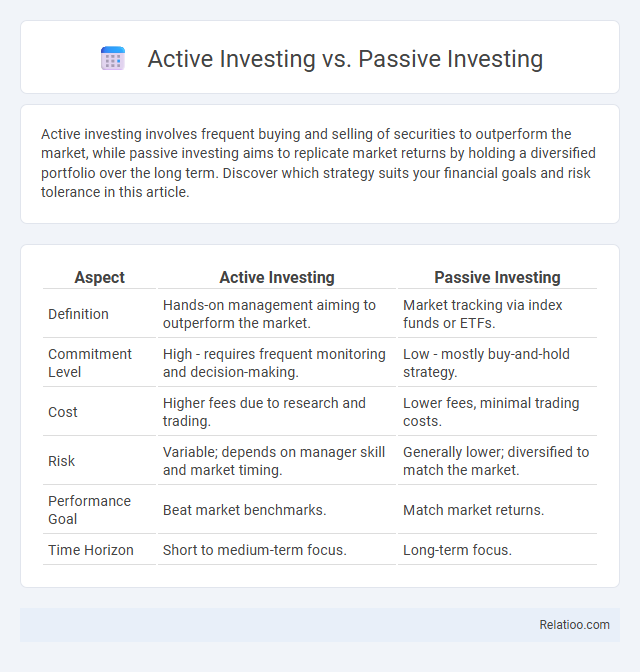Active investing involves frequent buying and selling of securities to outperform the market, while passive investing aims to replicate market returns by holding a diversified portfolio over the long term. Discover which strategy suits your financial goals and risk tolerance in this article.
Table of Comparison
| Aspect | Active Investing | Passive Investing |
|---|---|---|
| Definition | Hands-on management aiming to outperform the market. | Market tracking via index funds or ETFs. |
| Commitment Level | High - requires frequent monitoring and decision-making. | Low - mostly buy-and-hold strategy. |
| Cost | Higher fees due to research and trading. | Lower fees, minimal trading costs. |
| Risk | Variable; depends on manager skill and market timing. | Generally lower; diversified to match the market. |
| Performance Goal | Beat market benchmarks. | Match market returns. |
| Time Horizon | Short to medium-term focus. | Long-term focus. |
Understanding Active Investing
Active investing involves a hands-on approach where fund managers or individual investors continuously analyze market trends, economic data, and company performance to make strategic buy and sell decisions aimed at outperforming benchmarks. This method contrasts with passive investing, which seeks to replicate market indices and involves less frequent trading, typically resulting in lower management fees and reduced transaction costs. Understanding active investing helps you evaluate whether the potential for higher returns justifies the increased risk, effort, and expenses compared to passive investment strategies.
What is Passive Investing?
Passive investing is a strategy that aims to replicate the performance of a specific market index, such as the S&P 500, by holding a diversified portfolio of assets that mirror the index components. This approach minimizes trading activity and management fees while providing broad market exposure and reducing the risk associated with individual stock selection. If you prioritize lower costs and steady long-term growth, passive investing can be an efficient method to build wealth without actively managing your investments.
Key Differences Between Active and Passive Investing
Active investing involves frequent buying and selling of securities to outperform market benchmarks, relying on market timing and security analysis, while passive investing aims to replicate the performance of a market index through buy-and-hold strategies with minimal trading. The key differences include cost efficiency, with passive funds typically having lower expense ratios due to less management, and performance variability, where active funds may achieve higher returns but also carry greater risk and inconsistent outcomes. Investors choose between these strategies based on their risk tolerance, investment goals, and market outlook.
Pros and Cons of Active Investing
Active investing involves frequent buying and selling of securities to outperform market indexes, offering the potential for higher returns but with increased risks and higher fees. Your portfolio can benefit from professional management and market insights, yet active strategies may underperform due to transaction costs and market timing challenges. Unlike passive investing, which tracks indices with lower costs and less effort, active investing demands careful consideration of its time-intensive nature and variable outcomes.
Advantages and Limitations of Passive Investing
Passive investing offers advantages such as lower fees, reduced transaction costs, and broad market exposure by tracking an index, making it a cost-effective strategy for long-term growth. However, its limitations include limited flexibility to react to market fluctuations and no potential for outperforming the market. Your choice between active and passive investing should consider these trade-offs based on your investment goals and risk tolerance.
Costs and Fees: Active vs Passive Strategies
Active investing typically incurs higher costs and fees due to frequent trading, portfolio management, and research expenses, often resulting in expense ratios above 1%. Passive investing, such as index fund strategies, usually involves lower costs with expense ratios often below 0.2%, leveraging minimal turnover and automated management. Investors should weigh these cost differences against potential returns, as high fees in active strategies can significantly erode investment gains over time.
Performance: Historical Returns Comparison
Active investing targets outperforming market benchmarks through frequent trading and expert stock selection, often resulting in higher fees and variable performance. Passive investing follows market indices with lower costs and historically delivers consistent returns close to the overall market average over the long term. Your choice between active and passive investing strategies should consider the historical returns comparison, cost implications, and your risk tolerance to optimize investment performance.
Risk Management in Active and Passive Approaches
Active investing involves frequently buying and selling securities to capitalize on market inefficiencies, requiring continuous risk management through market analysis and tactical adjustments. Passive investing relies on tracking market indexes with minimal trading, emphasizing risk management by diversification and long-term market exposure to reduce volatility. You can balance risk management by choosing an investment strategy aligned with your risk tolerance, whether actively adjusting positions or passively holding diversified assets.
Which Strategy Fits Your Investment Goals?
Active investing involves frequent buying and selling of securities to outperform the market, while passive investing tracks a market index with lower fees and less risk. Your choice between these strategies depends on your risk tolerance, investment timeline, and financial goals. Understanding the differences helps you tailor an investment approach that aligns with your desired returns and commitment level.
Expert Tips for Choosing the Right Investment Style
Active investing involves frequent buying and selling of securities to outperform market benchmarks, while passive investing tracks a market index with minimal transactions for lower fees. Expert tips for choosing the right investment style include assessing risk tolerance, investment horizon, and cost awareness, as active investing may suit those seeking higher returns and willing to manage volatility, whereas passive investing is ideal for long-term, low-cost growth. Evaluating personal financial goals and consulting with financial advisors can optimize the balance between active and passive strategies for portfolio diversification and risk management.

Infographic: Active Investing vs Passive Investing
 relatioo.com
relatioo.com